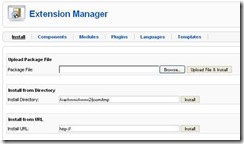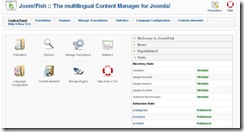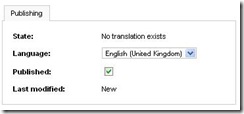How to Make Multilanguage Joomla Site
Joomla interface is translated to a great number of languages. And Joomla allows you to create multilanguage site. This article will show you how to create your multilanguage site using Joom!Fish Joomla extensions.
Before we proceed to working Joom!Fish, you need to be sure that you have all required languages installed to your site.
How to install a new language in Joomla
First of all, you should download the language pack which you wish to install. You can find a lot of language packs here.
Once you have downloaded the language pack, you can install it from your Joomla admin area:
- Navigate to Extensions > Install/Uninstall;
- Within Upload Package File area, click Browse button and select the downloaded package on your local PC:

- Click Upload File & Install button.
I recommend to pick one of the installed frontend languages as the site default language as this will simplify your translation process. So please set one of the newly-installed languages as your Joomla’s default:
- Open Extensions > Language Manager;
- Once there, simply check the box next to the language you wish to set default and then click the Default button located at the top-right Joomla menu.
Joom!Fish
Currently Joom!Fish is the best solution to make your site multilanguage. It supports that you can write your original content in any language you like and afterwards translate it to the other languages
The main abilities of Joom!Fish are:
- Allows to supporting of unlimited number of languages;
- Allows to store and translate manually any dynamic entries and keep them in a single database;
- Supports exterior extensions besides the standard com_content;
- Supports translations of front-end;
- …and many others
You can get more information about Joom!Fish at http://www.joomfish.net/.
So, to begin working with Joom!Fish download and install it first. Installation process for the component is similar to installation process of language.
Then navigate to Components > Joom!Fish. Now you need to make sure that the component is ready for work.
Being on the Control Panel, expand State area on the right side of the page:
Within the State area, carefully view Directory State and Extension State. This shows the state of all directories required for working with this component (should be writeable for stable working) and state of additional extensions that are auxiliary for Joom!Fish and are installed from the same package.
Attention! If there are any errors, you should determine a cause of error and eliminate it. There is no sense to work with the extension until do it.
Going on. Switch to Language Configuration tab and activate the languages you want to use on your site: just check the required languages within the Active column of the table and click Save.
The next stage is to make a translation for some content element. Navigate to the Translation tab:
Then select an element to be translated:
- Select the target language the element will be translated to from the Languages list (top right corner on the pic.);
- Select the type of content element from the Content elements drop-down list;
- Use filter for the further selecting of the element if necessary;
- From the compiled list of elements that meet your requirements, select the element to be translated;
- Click Edit.
To the right of the appeared page, you will see element publishing info. For example:
Make sure that the desired target language is selected and that the element is published.
View it and proceed to the translation itself. Read the original text and insert your translation into the Translation area below.
Note: Besides content translation, Joomla allows to translate title, aliases and other labels for the selected element.
Click Save when done.
Language Selection
Besides its main features, Joom!Fish provides useful extension that serves for appearance of language selector on your site. This is Language Selection module.
To adjust the appearance of language selector, you should:
- Navigate to Extensions > Module Manager;
- Select Language Selection from the list of modules and click Edit;
- Make the required settings within the Parameters (Basic) area:

- Select the desired appearance of language selector from the respective drop-down list: drop down of names, drop down of names with current language flag, ul-list of names, ul-list of names with flag, ul-list of images or raw display of images.
- Enable (Yes) or disable (No) showing of active language.
- Click Save.
Have fun! ![]()










Thanks!! This article really helped me alot. I am novice to joomla. Few days back i downloaded Joomfish, i was working on that but not getting my work odne. Your sequenced instructions helped me alot.